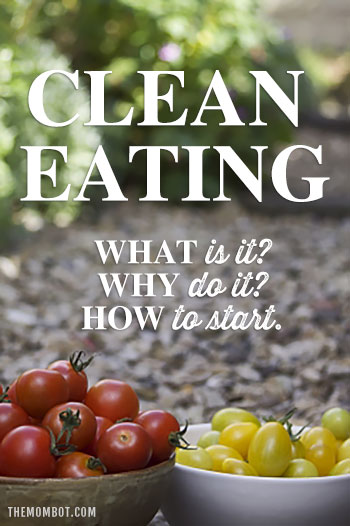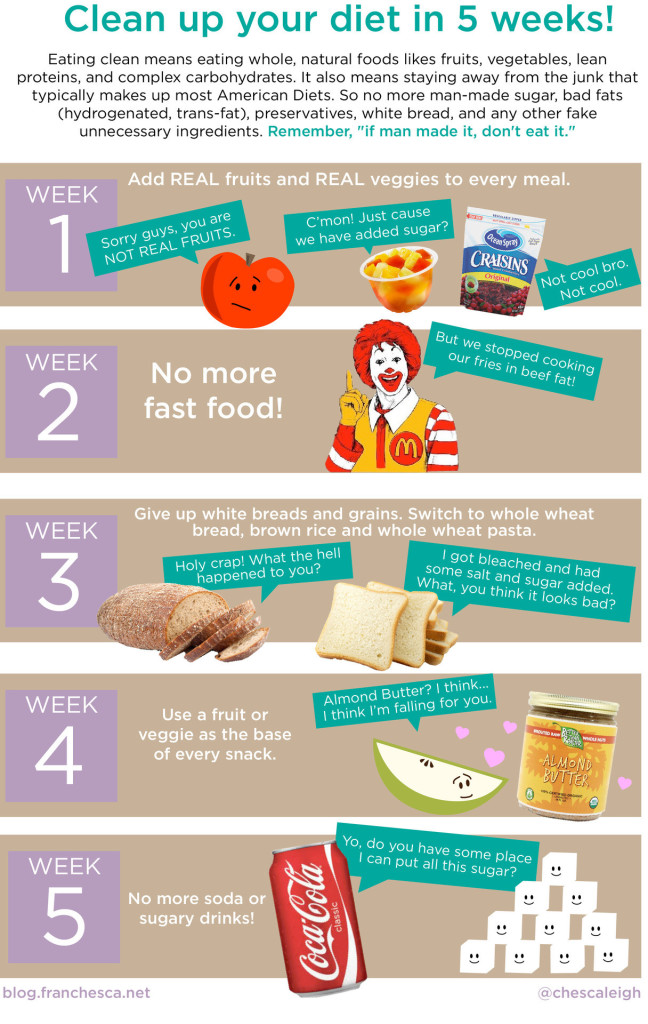If you have absolutely no interest in reading me go on about what clean eating is and why we are now following a clean diet as a family, then feel free to skip right over this post. I’m not going to turn my blog into a clean eating bible or start preaching on how I think you’re a horrible mom for going through the McDonald’s drive-thru, but I did want to touch on the subject since it’s a big part of our life right now and something I whole-heartedly believe in.
I’ve learned so much in these last few months about actual nutrition and what having “healthy eating habits” really means – I feel like if others were introduced to some of this same information, they might be enlightened too! America on the whole is so misinformed and confused about food and nutrition and it makes me eternally frustrated with all the wrong messages and information we are fed (no pun intended).
So if you have any interest, please read on. If not, I’ll see you next time!
What is clean eating?
Clean eating means lots of different things to different people, and there are many levels of a clean diet that you can follow. That’s what I like about it; you can dive in as far as you want, which should help dissolve any reservations you might have. I hesitate to even refer to it as a “diet” because it’s not a diet, but rather a lifestyle – and I have to say that I don’t think you will feel very deprived of anything as a clean eater (except for that occasional chicken nugget run – or is that just me?) like you often do with diets.
Learning about substitutions and work arounds for familiar recipes has been both fun and informative for me. Clean eating doesn’t mean you have to give up pizza night or enchiladas, it just means you have to pay attention to ingredients and perhaps sub some things.
I think that Clean Eating magazine describes it best:
“The soul of clean eating is consuming food in its most natural state, or as close to it as possible. It is not a diet, it’s a lifestyle approach to food and its preparation, leading to an improved life – one meal at a time.”
I used to think I would need to eat weird things like rutabagas and anchovies and beets in order to eat clean. I don’t know why… But once I dove in, I realized it’s so simple and doesn’t have to be weird at all (unless you want to start eating rutabagas and anchovies, which I don’t particularly).
Clean Eating magazine (and I) suggest the following:
- Eat five to six times a day – including 3 meals and 2 snacks. Include a lean protein, plenty of fresh fruit and veggies and a complex carb with each meal. This will keep your body energize and burning calories efficiently throughout the day.
- Drink at least two liters of water a day.
- Check the labels: clean foods contain short ingredient lists; any product with a long list is human-made and not considered clean. Pay attention to things like “enriched wheat flour” when it should be “whole wheat flour” and anything containing “high fructose corn syrup” or any sort of preservatives – those are a no-no.
- Choose organic whenever possible (start with the Dirty Dozen, dairy, eggs, and meat as priorities if you are on a budget). I always buy organic for the Dirty Dozen, and I’ve recently switched over to organic eggs and butter. My meat is not organic, but it is all natural, grass-fed meat that I usually pick up at Sprouts Farmers Market. And I have to say on the whole, it tastes way better than the meat I used to buy and I don’t feel like it’s that much more expensive – organic meat, on the other hand, tends to be VERY expensive in my eyes, which is why I rarely buy it. You have to decide what works for your family and your budget.
- Avoid processed and refined foods such as white flour, sugar, bread and pasta. Enjoy complex carbs such as whole grains instead. We’ve started eating mostly quinoa, brown rice and whole wheat pasta with our meals. Everything I bake now has whole wheat or white whole wheat flour and I began using sweeteners like maple syrup, honey and succanat instead of refined white and brown sugars. It’s been an easy transition, quite honestly.
- Steer clear of anything high in trans fats, anything fried or anything high in sugar.
- Take it to go: Pack a cooler for work or outings so you’ll always have clean eats on the go. Make snacks for your kids instead of buying prepackaged ones at the beginning of the week so you have something to grab throughout the week as needed. These breakfast cookies are great, as are these homemade granola bars.
- Shop with a conscience: consume humanely raised and local meats.
Why follow a clean eating lifestyle?
I am truly a believer in clean eating, because it’s changed the way I feel and think. Health wise, I feel so much better than I used to. I no longer feel sluggish after meals and I am never so full that I feel sick (unless we go out to eat, which is rare, when I tend to overeat thanks to their gigantic portion sizes). That sleepy low that usually sets in after lunch has become few and far between – instead my energy is pretty consistent throughout the day. My weight has stayed incredibly steady – true, I have a fast metabolism and am thin by nature, but after having Graham, I shrunk down quicker than I did with the other two and have stayed consistent. Many people see results in weight loss when following a clean eating diet. My digestive system is also on the up and up (you know what I mean, I’ll spare you the details).
Call me crazy – but I also think it’s done wonders for our health. Everyone, and I do mean EVERYONE we know with kids has been sick with colds and the stomach flu since the beginning of fall. It’s been a rough flu season and I heard that the vaccine isn’t all that effective this year. My entire family has remained healthy until just last week, the second week of January, when all three kids became congested. They are already on the mend. Both my husband and I have been completely healthy all season, and neither of us got flu shots. It could be luck that we stayed so healthy for so long, but I am leaning towards our eating habits as a big factor.
Now that I know how I feel when eating clean, I am kind of amazed that I ate man-made ingredients for so long. I mean, what was I putting in my body? I really have no clue, because I can’t even pronounce most of those ingredients let alone figure out what they really are. I can’t fathom why we buy peanut butter full of sugar when peanuts are delicious in their natural state… Or why our whole wheat bread needs to be full of high fructose corn syrup and all those preservatives? If I made it at home, it wouldn’t contain half of the ingredients listed on most labels.
It’s also changed my entire mental attitude regarding my grocery shopping budget. Suddenly this frugalista doesn’t mind paying more for the organic lettuce and grass-fed meats. I used to be hardcore when it came to couponing, now I rarely cut them out (which is kind of a blessing because no one actually enjoys clipping coupons), because there are hardly any coupons for the items I buy. My husband and I both decided that if we were going to spend our money somewhere, it should be on healthy food. Giving my children health is far more important to me than couponing so that I can buy them more clothes. And teaching them about how and what to eat will produce life-long healthy eating habits (at least, that’s the hope).
I have learned SO much since I started this journey 6 months ago. I know more about ingredients than ever before and I have tried so many foods I was afraid of and thought I didn’t like. My favorite thing to eat now? Quinoa and sweet potatoes. Who knew? I always liked cooking, but I really love cooking now. I have a real sense of pride when I cook something that is healthy and delicious and my family gobbles it up. If there’s one thing I want to do for them, it’s fuel them with the appropriate foods.
How can I get started?
It’s simple; don’t let it be complicated or psyche you out. You can start with a simple 5-week program (found here):
Or consider some of these things:
- Start by always, always looking at the ingredients on the label. If you don’t know what it is, you likely shouldn’t be consuming it. Look for whole wheat flour in your complex carbs and don’t buy whole wheat bread with high fructose corn syrup – my regular grocery store doesn’t even carry any without it… I buy mine at Sprouts for only $2.99 a loaf and it only contains a handful of ingredients. Look at everything – and I do mean everything; even ketchup and hamburger pickles tend to have high fructose corn syrup!
- Go slowly – you don’t need to go through your entire pantry and fridge and throw everything away and start from scratch (I am still an advocate of saving money, not wasting it!). Instead, weed things out slowly and as you run out of something, replace it with a clean alternative. Still have white flour lasagna noodles? Make a lasagna this week and the next time you head to the store, replace them with whole wheat ones.
- Consume a lot of fruits and veggies – try new things and seek out new recipes. Paleo recipes can be good, as can gluten free. Just because you aren’t following those diets all the time doesn’t mean you can’t use some of their recipes. For ideas, you can follow my Healthy Eating / Clean Eating Pinterest board. I’ve made tons of these recipes already and rely on them heavily. Just note, some of the recipes contain non-clean ingredients that I know I can work around or sub to make it clean, so use your discretion.
- Plan and prepare: Start meal planning if you don’t already do it. Being prepared is the best way to staying on track. If you don’t have the time or energy, consider subscribing to Clean Eating magazine – each issue has a two-week meal plan in it complete with shopping list. It’s SO easy. Along the same lines, commit to making one homemade snack a week so that your family will always have something to eat in a rush and you won’t succumb to pre-packaged processed foods. I like baking a treat like banana bread or granola bars. Trail mix is also easy to make.
- Change the way you used to think about healthy foods and avoid everything labeled as “low fat,” “fat free,” “light” or “lite,” and “reduced fat.” Everything they have to do to make a food lower in fat means it’s definitely not in it’s natural state.
- Limit your beverages to coffee, water, milk and tea.
Want more ways to get started? Here’s a great 13-step (one step per week) process written by one of my favorite clean eating bloggers, Lisa from 100daysofrealfood.com.
More Info:
Blogs to follow for more resources and information:
100daysofrealfood.com
Fortheloveof.net (food & wellness section)
photo credit: Simon Howden, FreeDigitalPhotos.net
Disclosure: Affiliate links used

